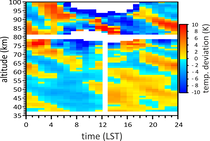Atmospheric tides
Atmospheric tides are global-scale oscillations initiated by daily periodic absorption of solar radiation in the atmosphere. Periods of 24, 12 and 8 hours occur most frequently. Tides are primarily excited by the absorption of infrared radiation by tropospheric water vapor (diurnal tide), and ultraviolet radiation by stratospheric ozone (semidiurnal tide). They propagate from the lower atmosphere into the thermosphere, interact with other atmospheric waves, and transport energy and momentum over large scales. Thus tides are important for the dynamical coupling of atmospheric layers.
Tides are observed in basic atmospheric parameters like temperature and wind, as well as in layered phenomena like mesospheric ice particles and metal atoms.
Ground-based instruments detect tides as persistent amplitude variations of the measured parameter (i.e. temperature) as function of local time. Such investigations are made by IAP using several lidars at different latitudes.
The temperature variations shown here are caused by tides. Amplitudes up to 10 K are observed above Kühlungsborn, depending on altitude. Temperature tides are also observed over Antarctica (Davis, 69°S), with surprisingly large amplitudes of about 8 K in the mesopause region. Such temperature variations directly impact the existence of mesospheric ice particles. Hence, noctilucent clouds (NLC) show tidal signatures as observed at the arctic station ALOMAR (69°N) and above Kühlungsborn.
Selected publications
- K. Baumgarten and G. Stober, On the evaluation of the phase relation between temperature and wind tides based on ground-based measurements and reanalysis data in the middle atmosphere, Ann. Geophys., 37, 581-602, doi:10.5194/angeo-37-581-2019, 2019.
- K. Baumgarten, M. Gerding, G. Baumgarten und F.-J. Lübken, Temporal variability of tidal and gravity waves during a record long 10 day continuous lidar sounding, Atmos. Chem. Phys., 18, 371-384, doi:10.5194/acp-18-371-2018, 2018.
- J. Fiedler und G. Baumgarten, Solar and lunar tides in noctilucent clouds as determined by ground-based lidar, Atmos. Chem. Phys., 18, 16051-16061, doi:10.5194/acp-18-16051-2018, 2018.
- F. Schmidt, G. Baumgarten, U. Berger, J. Fiedler und F.-J. Lübken, Local time dependence of polar mesospheric clouds: A model study, Atmos. Chem. Phys., 18, 8893-8908, doi:10.5194/acp-18-8893-2018, 2018.













